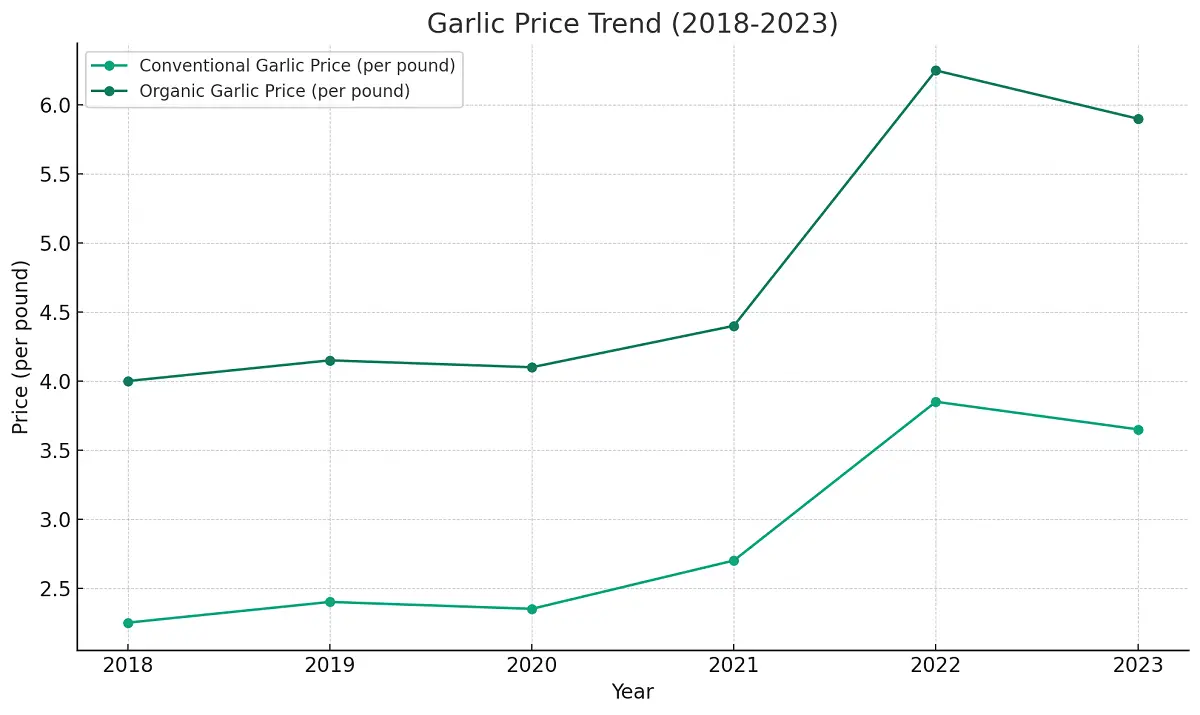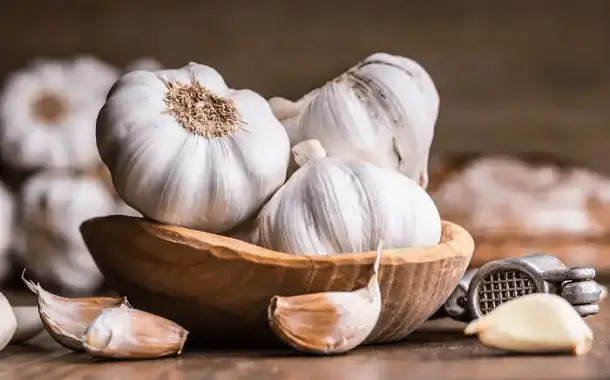How Much Does Garlic Cost?
Last Updated on September 12, 2023
Written by CPA Alec Pow | Content Reviewed by ![]() CFA Alexander Popinker
CFA Alexander Popinker
Garlic is a medicinal plant used for over 4,000 years to treat many ailments, as well as the basic food and spice of many dishes. This is a plant rich in minerals, vitamins, and medicinal compounds that give it a strong antibiotic, fungicidal, and anticancerous effect. , The bulb and the young leaves of garlic will be used for medicinal purposes and in food recipes. Garlic is part of the Allium family, being related to onions, shallots, and leeks.
Originally, garlic comes from Central Asia and is grown mainly in Japan, China, and other parts of the Far East. At the same time, garlic was consumed in large quantities by the ancient Greeks, but also by the Egyptians. Currently, it is grown in large areas of Europe, especially in the central and south-eastern areas, but also in Asia and North America.
How Much Does Garlic Cost?
At grocery stores garlic can cost anywhere between $0.75 and $1.50 per individual clove. At local farmer’s markets, you can purchase garlic for anywhere between $4 and $10 per ¼ pound depending on the variety.
Also, at local farmers’ markets, fresh garlic bulbs are sold for around $15 per pound.
You might also like our articles on the cost of onions, potatoes, or zucchinis.
According to the Gardenweb.com website, the cost of one pound of garlic is around $10 and a single garlic clove can be bought for $1.
Expect to pay anywhere between $7 and $11 per 16-ounce container of minced garlic. For instance, Walmart’s Great Value brand is sold for around $9.
Edible powdered garlic is also available on the market and is ideal for seasoning and flavoring the food. Plan on spending anywhere between $3 and $5 for a three-ounce container of garlic powder.
According to the Profitableplantsdigest website, the cost of gourmet garlic is around $19 per pound. Also, they say that the Purple Stripe and Rocambole varieties are pretty hard to find on the market.
Important things to consider
Recent studies have found that the use of garlic in the diet has many health benefits and is associated with a possible decrease in the incidence of stomach cancer. Garlic is an excellent source of minerals and vitamins that are essential for optimal health.
Garlic is one of the richest sources of potassium, iron, calcium, magnesium, manganese, zinc, and selenium. With only 100 g of garlic, we can get 95% of the daily requirement of vitamin B-6 (pyridoxine), 39% of vitamin C, 33% of copper, 21% of iron, 18% of calcium, 26% of selenium, and 73 % manganese while it contains no cholesterol at all. Contains approx. 150 calories per 100 grams.
In the store, we can find a wide range of garlic, such as whole bulbs, and dried cloves, in the form of powder or paste.
Dried bulbs can be stored at room temperature, and placed in a cool dark environment away from moisture if they are to remain in good condition for several weeks.
Garlic pastes and other garlic preparations should be stored in the refrigerator.
Garlic is used in a variety of recipes, cloves themselves but also in combination with other plants, like thyme, for preparing dishes.
In general, the leaves are less spicy than cloves. Cloves are finely chopped or crushed and then added to the preparations.
It is used to enhance the flavor of vegetables, meat, and seafood.
Garlic cloves are also used to give a slightly spicy taste to some foods. For example, toast on the grill rubbed with a small piece of garlic and toppings, such as olive oil, pepper, tomatoes, cheese, meat, etc.
It is also used to season soups, broths, and vegetable sauces for best results.
Types of garlic
Garlic is classified according to its flavor profile and culinary use. The most common types of garlic include:
Softneck Garlic (Allium sativum var. sativum):
Artichoke Garlic: This is one of the most common types of garlic found in grocery stores. It’s known for its mild, almost sweet flavor and is versatile in many dishes. The cloves are typically easy to peel, making garlic a convenient choice for everyday cooking.
Silverskin Garlic: Silverskin garlic is often used for braiding due to its long storage life. It has a strong and spicy flavor, making it excellent for roasting and adding bold garlic notes to dishes.
Hardneck Garlic (Allium sativum var. ophioscorodon):
Rocambole Garlic: Rocambole garlic is favored by chefs for its complex and rich flavor. Its cloves are easy to peel, making it a practical choice for various recipes. The taste is often described as a well-balanced blend of spiciness and richness.
Purple Stripe Garlic: As the name suggests, these garlic bulbs feature striking purple stripes on their wrappers. They have a strong and spicy flavor, perfect for adding a robust garlic kick to dishes.
Porcelain Garlic: Porcelain garlic is known for its large, easy-to-peel cloves and a full-bodied, hot, and robust flavor. It’s often used in recipes where the garlic flavor needs to shine.
Turban Garlic: This garlic type gets its name from its unique shape that resembles a turban. It offers a mild, slightly spicy flavor and is often used in gourmet cooking due to its distinctive appearance.
Elephant Garlic (Allium ampeloprasum):
Elephant garlic is not a true garlic but is related to leeks. It’s known for its large cloves and mild garlic-like flavor. While it lacks the intensity of true garlic, its size makes it a popular choice for those who want a milder garlic presence in their dishes.
The choice of garlic type can significantly impact the flavor profile of a recipe. Cooks and chefs often experiment with different garlic varieties to enhance and customize the taste of their dishes, whether they desire a subtle, sweet note or a bold, spicy kick of garlic flavor.
How to consume garlic
It is best to eat it raw, because allicin, its main enzyme, is destroyed by heat. One or two cloves of garlic during a meal have a beneficial medical effect. In order to have maximum benefits, it must be chewed raw, because by chewing its nutritional content is released and better absorbed by the body.
How to peel and mince garlic
Garlic: Precautions and contraindications
Overeating or consumption of yellow or sprouted garlic causes vomiting, heartburn, dyspeptic syndrome, bleeding, or nausea.
Garlic consumption is contraindicated to nursing mothers because it changes the taste of milk and can cause colic pains in the baby.
It is also contraindicated in people with digestive intolerance to garlic and those taking anticoagulant drugs.
The unpleasant smell of garlic can be removed by chewing a little parsley, dill, mint, anise, fennel, basil, coriander, or juniper.
Garlic price per pound over the last 5 years
The general trend has been moderately rising garlic prices over the past 5 years, with more significant increases likely from 2022 onward due to high inflation.
| Year | Conventional Garlic Price (per pound) | Organic Garlic Price (per pound) |
|---|---|---|
| 2018 | $2.25 | $4.00 |
| 2019 | $2.40 | $4.15 |
| 2020 | $2.35 | $4.10 |
| 2021 | $2.70 | $4.40 |
| 2022 | $3.85 | $6.25 |
| 2023 | $3.65 | $5.90 |
Here’s the chart showing the price trend of conventional and organic garlic from 2018 to 2023.

Garlic Price per Year
How will inflation affect the wholesale price of garlic in 2023
Inflation will likely contribute to higher garlic prices again in 2023, though the increases may moderate compared to 2022:
- Overall inflation is expected to cool somewhat in 2023 compared to the 40-year high levels reached in 2022. However, inflation will remain elevated compared to historical norms.
- Garlic prices tend to track broad food inflation, which is predicted to be 5-7% in 2023. This is down from 10%+ food inflation in 2022 which sharply increased garlic costs.
- As inflation drives up labor, transportation, packaging, and other input costs for garlic farmers and distributors, these higher expenses get passed on in the form of retail price increases.
- However, a recession could dampen consumer demand for higher-priced garlic. Weaker demand could create downward pressure on prices.
- Major weather events could further impact supply and yields, affecting inflationary impacts.
- Expect garlic prices to continue trending upward in the range of 5-10% in 2023 as inflation persists and production costs remain elevated. But the increases may be more moderate compared to 2022 spikes.
- Consumers may continue to see garlic costing $4 per pound or more at retail in 2023 due to these ongoing inflationary factors.
Here is an overview of some of the key factors influencing the price per pound of garlic according to the 2018 to 2023 timeline:
| Year | Key Factors |
|---|---|
| 2018 | – Labor costs rising steadily. |
| – Transportation and packaging costs | |
| increasing moderately due to oil | |
| prices. | |
| – Organic garlic maintains a price | |
| premium over conventional. | |
| 2019 | – Persistent labor cost increases. |
| – Weather impacts are minimal this year. | |
| – Strong consumer demand supporting | |
| higher prices. | |
| 2020 | – Minimal inflation environment. |
| – Stable transportation, packaging, and | |
| production costs. | |
| – Organic garlic price premium persists. | |
| 2021 | – Rising inflation taking hold, bumping |
| costs up. | |
| – Weather disruptions in major regions | |
| reduce yields. | |
| – Import restrictions enacted. | |
| 2022 | – Significant inflation spike drives up |
| costs throughout the supply chain. | |
| – Rising wages and fuel costs. | |
| – Reduced yields from heatwaves. | |
| 2023 | – Inflationary pressures persist though |
| moderating. | |
| – Extreme weather events continue | |
| impacting production. | |
| – Labor shortages requiring higher | |
| wages. |
How can I save money?
You can find fresh homegrown garlic at a good price at local farmer’s markets when this plant is in season.
Also, the more garlic you buy from these local markets in one go the more you can save. Most of the farm growers are offering bulk discounts for garlic.
Take into consideration growing garlic at home. This is not that hard and you can find many tutorials and guides online about how to do it.


Leave a Reply
Want to join the discussion?Feel free to contribute!